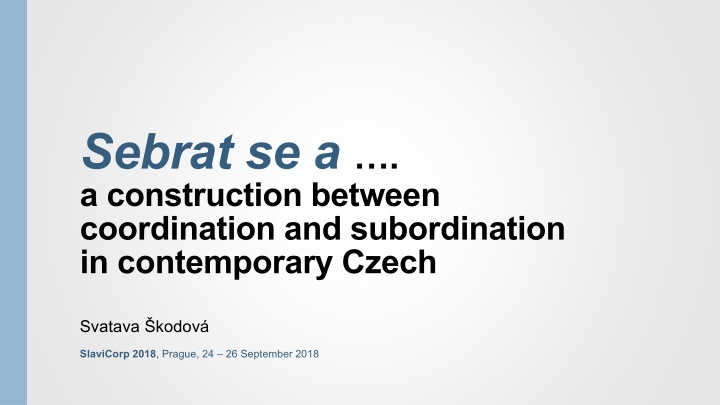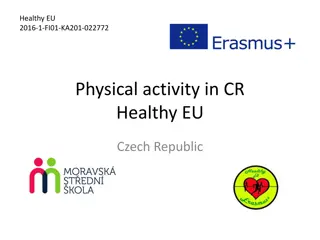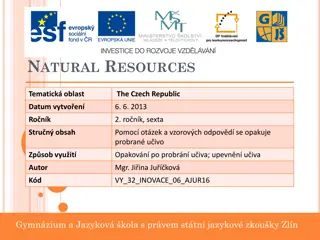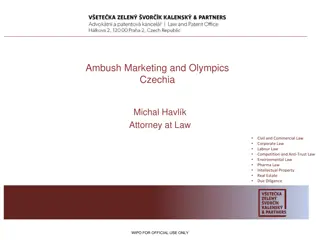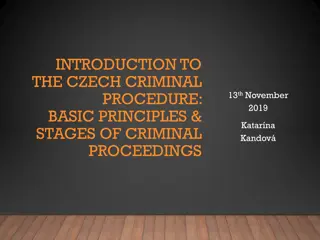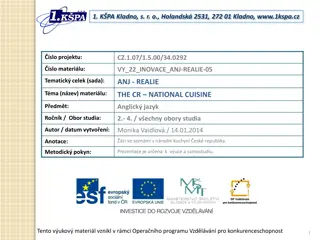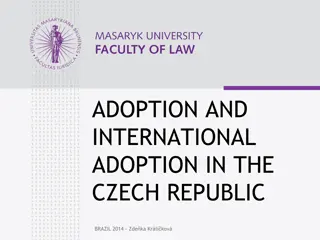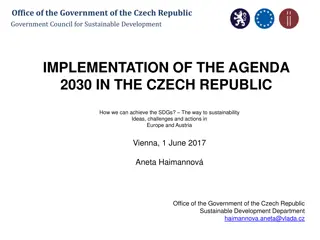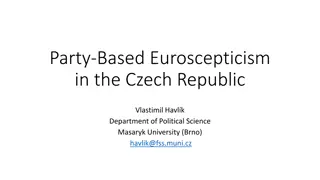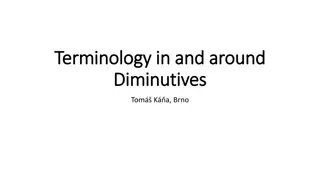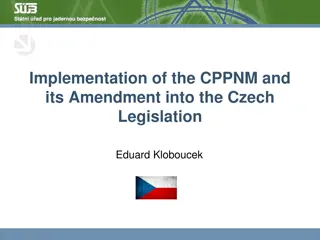Pseudocoordination in Contemporary Czech Analysis
Delve into the concept of pseudocoordination in contemporary Czech language, exploring the intricate relationship between coordination and subordination. Explore examples of two-verb complexes, the use of light verbs, and the unique properties of pseudocoordination constructions. Unravel the complexities of constructions that blur the lines between coordination and subordination, offering insight into this linguistic phenomenon.
Download Presentation

Please find below an Image/Link to download the presentation.
The content on the website is provided AS IS for your information and personal use only. It may not be sold, licensed, or shared on other websites without obtaining consent from the author.If you encounter any issues during the download, it is possible that the publisher has removed the file from their server.
You are allowed to download the files provided on this website for personal or commercial use, subject to the condition that they are used lawfully. All files are the property of their respective owners.
The content on the website is provided AS IS for your information and personal use only. It may not be sold, licensed, or shared on other websites without obtaining consent from the author.
E N D
Presentation Transcript
Sebrat se a . a construction between coordination and subordination in contemporary Czech Svatava kodov SlaviCorp 2018, Prague, 24 26 September 2018
Content a survey of pseudocoordination 1. 2. exemplified by Czech verb sebrat se a 3. a coordinate form displays subordinate properties, with resulting constructions that cannot be clearly categorized as either coordination or subordination.
Pseudocoordination - definition a two-verb complex: light verb and main verb V1 sebrat se a/and V2 a type of coordination that uses coordinator and on the surface level for connection of two verbs into a construction V1aV2, without coordinating two events the verb in the first position V1 can lose its primary meaning the event expressed by the verb in the position V2 is modified Typical verbs: go, sit, tak 1. Seber se a hledej znovu! /Go and look for him again. 2. Seber se a padej! / Go on, get moving! 3. Sebrala se a hned se vr tila. / She picked herself up . She came straight back .
Pseudocoordination - definition Use of the coordinator and in constructions that behave unlike typical coordination The constructions display some properties of coordination and cannot be definitively identified as either coordination or subordination Observations of the phenomenon can be found as early as comments on Spanish 1500s (Ross, 2017) Inconsistent nomenclature: pseudocoordination, verbal hendiadys, fake coordination, serialization, verb-verb agreement, The term pseudocoordination - descriptions of the Scandinavian Germanic languages (cf. Kvist Darnell 2008)
PseCoor crosslinguistically Swedish Gunl g, 1991; Wiklund, 2005; Darnell, 2008, Norwegian L drup, 2002, English Carden Pesetzky, 1997, Grootjen- Kamphuis Sarbo, 1999; Quirk, 2000; de Vos, 2005; 2007 Ross, 2017 - overview of the distribution of PseCoor; found in 46 languages Russian Kuznetsova, 2006 Czech kodov , 2009 (j t/go)
Sebrat se Sebrat se a V2 Translation: Translation: ????? - Pick up - Brace up - Compose oneself - pull oneself together Seberte se a zhluboka se nadechn te . /Pull yourself together and take a deep breath .
Sebrat se vs. Sebrat se a V2 SSJ (1994) zotavit se/recollect someone; vzchopit se/got to someones feet S FI, V razy slovesn (2009) sebrat se a j t ( l. zvl. odn kud pry , obv. bez zavazadel apod.;) n hle n. rychle se rozhodnout a j t n. odej t, obv. bez p pravy, pop . i rozlou en . = go suddenly, quick decision, without any preparation, without any luggage, without saying farewell.
Data Czech National Corpus sebrat se a V2 SYN2015 InterCorp (Cz/Aj) 245PseCoor/8ProCoor 264PseCoor/10ProCoor 97 transl. 170 non-transl. 559PseCoor
Sebrat se a V2 Verbs of motion prevailing: J t/go; vr tit se/go back, vstoupit/ enter a room; odej t/ go away; b et/ run; zmizet/ disappear; za t cestovat/start travelling; chytit/ get up sth; vz t do zaje ch/run; Various verbs Zazvonit/rign the bell; ud lat n co/ do sth; vst t/get up; pom hat/ run an interference; up t se/ drink to the death; neprorazit skrz/ charg through; zbavit se n eho/get rid of sth; pomoci/hepl; zvolat/ call sb; koupit n co/buy sth; nechat n koho/leave sb; pozab jet/kill; hledat/seek; postavit/build; sednout do n eho/ sit; nandat n komu/ fight sbd; vz t n koho n kam/tak sbd sw
ProCoor vs. PseCoor charakteristics ProCoor PseCoor Word order of the conjuncts is not grammaticalised, it can be mixed. Word order of the coordinated verbs can not be changed. Coordinated verbs have own meaning. First verb is semanticaly bleached. The conjuncts are semantically and grammatically independent. The conjuncts are grammatically dependent (morphologically, syntactically).
PseCoor vs. Subordination Serial verb constructions Serial verbs construction: two or more verbs are strung together in a single clause. = subordination 1. Poj me j st./ Let s go eat. 2. P ij si pov dat./ Come talk with me. PseCoor similar but joint by a conjunction. 1. Sebral se a el nakupovat./ He picked himself up and went shopping. 2. ? Sebral se nakoupit. (inf: to shop)/ He picked himself up to shop. 3. ? Sebral se k n kupu. (noun: a shopping)/ He picked himself up shopping.
sebrat se a V2 restriction of the coor. features
Semantic bleaching Semantically empty V1 seber se is not translated 1. Seber se a jdi./ Move! 2. Seber se a vypadni ./ Get out ! Sometimes translated as a verb of motion: 1. Sebral se a el k matce . / He just took off and went to your mother 's . 2. Seber se a chy TO ! / Get up and get IT up ! 3. Seber se a hledej znovu ! / Go and look for him again . 4. Seber se a padej ! / Go on , get moving !
Semantic bleaching Q test Sebral se a el k matce . He just took off and went to your mother 's . A: Co ud lal v era? /What did he do yesterday? B: * Sebral se./ He just took off. B: el k matce./He went to your mother 's. B: Sebral se a el k matce . He just took off and went to your mother 's . ProCoor A: What did he do yesterday? B: He went to school and met his friends.
Word Order of the conjuncts PseCoor: Consequence of the stages of one event Sebral se a zmizel , jen co se narodilo t et d t . 1. He up and left soon 's the third kid came along . * Zmizel a sebral se, jen co se narodilo t et d t . 2. * He left soon and up as the third kid came along. ProCoor ProCoor allows one to reorder the conjuncts provided there is no consecutive ordering of events inferred from encyclopedic knowledge. John cut a mushroom and washed an apple 1. John washed an apple and cut a mushroom. 2.
Same subject PseCoor: conjuncts share the same subject 1. Trevor se sebral a zmizel i s pen zi . /Trevor had just walked away , with his cash . 2. *Trevor se sebral a Jan zmizel i s pen zi . /Trevor had just walked away , with his cash . ProCoor: subjects of the coordinated verbs can differ 3. John slept and Jane read a book.
Shared morphology PseCoo: both coordinated verbs have the same morphological specification Person + Number 1. To ale neznamen , e se seberou a odejdou. (V1 3st pers; pl and V2 3rd person; pl) 2. But that does n t mean you just up and leave . 3. * To ale neznamen , e se seberu a odejdou . (V1 1st person; sg and V2 3rd person; pl) Aspect 4. Jednoho dne se sebral a u se nevr til./He left here one day and never came back . V1 finite + V2 finite 5. *Jednoho dne se sebral a u se nevracel./He left here one day and never came back . V1 finite + V2 infinite
Shared morphology Tense 1. Za 45 minut se seberu a p jdu pry . (V1 fut and V2 fut) In 45 minutes , I 'll get up and go away . Mood 2. Tak se seber a jdi do toho! (V1 imperat and V2 imperat) So you just go off and do it! Negation 3. Pro se nesebere a nezavol jim ? (V1 neg and V2 neg) Why do n't you go and pay a call on them ?
Adverbial specification PseCoor: If there is an adverbial specification (time, manner) it reaches at the both verbs 1. A v era se najednou sebral a el ho zastavit ./ And yesterday he suddenly went out and stopped it . 2. *A v era se najednou sebral a dnes el ho zastavit ./ And yesterday he suddenly went out and today he stopped it .
Why? Is there any contribution of the construction?
Semantic contribution of the sebrat se a V2 construction 1. actual beginnig of an event 2. continuous action; progressive aspect; progress of an event to its right boundary 3. surprise and unexpectedness 4. annoyance, disapproval
Conclusion subordination is morphosyntactically dependent and structurally embedded, coordination as morphosyntactically independent and not embedded, pseudocoordination is morphosyntactically dependent but not embedded construction SEBRAT SE a V2 stands between coordination and subordination; we characterise it as pseudocoordination 1 event sebrat se a v2 1st phase of the event. 2nd phase of the event sudden decision for an action the action itself realisation of an action in near future
References AIKHENVALD, Alexandra Y. 2006. Serial Verb Constructions in Typological Perspective. In Alexandra Y. AIKHENVALD and R. M. W. DIXON (eds.) Serial Verb Constructions: A Cross-Linguistic Typology. Oxford: Oxford University Press, 1-68. AIROLA, Anu. 2007. Coordinated Verb Pairs in Texts. PhD Dissertation. University of Helsinki. http://urn.fi/URN:ISBN:978-952-10- 4250-8 BJERRE, Anne and Tavs BJERRE. 2007. Pseudocoordination in Danish. In Stefan M LLER (ed.) Proceedings of the HPSG07 Conference. Stanford: CSLI Publications, 6-24. CARDEN, Guy and David PESETSKY. 1977. Double-Verb Constructions, Markedness, and a Fake Co-ordination. Chicago Linguistics Society 13: 82-92. CARDINALETTI, Anna and Giuliana GIUSTI. 2003. Motion Verbs as Functional Heads. In Christina TORTORA (ed.) The syntax of Italian dialects. New York: Oxford University Press, 31-49. CULICOVER, Peter W. and Ray JACKENDOFF. 1997. Semantic subordination despite syntactic coordination. Linguistic Inquiry 28(2): 195-217. EBERT, Karen H. 2000. Progressive markers in Germanic languages. In Osten DAHL (ed.) Tense and aspect in the languages of Europe. Berlin: Mouton de Gruyter, 605-653. HASPELMATH, Martin. 2005. Nominal and Verbal Conjunction. In Martin HASPELMATH, Matthew S. DRYER, David GIL and Bernard COMRIE (eds.) World atlas of language structures. Oxford: Oxford University Press, 262-265. HASPELMATH, Martin, Matthew S. DRYER, David GIL and Bernard COMRIE (eds.). 2005. World atlas of language structures. Oxford: Oxford University Press. http://wals.info/. HASPELMATH, Martin and Ekkehard KO NIG (eds.). 1995. Converbs in cross-linguistic perspective: structure and meaning of adverbial verb forms adverbial participles, gerunds. Berlin: Mouton de Gruyter. HEINE, Bernd and Tania KUTEVA. 2002. World Lexicon of Grammaticalization. Cambridge: Cambridge University Press.
HEYCOCK, Caroline and Hjalmar P. PETERSEN. 2012. Pseudocoordination in Faroese. In K. BRAUNMUELLER and C. GABRIEL (eds.) Multilingual Individuals and Multilingual Societies. Hamburg: John Benjamins, 259-280. KIPARSKY, Paul. 1968. Tense and Mood in Indo-European Syntax. Foundations of Language 4(1): 30-57. ROSS, Daniel, Ryan GRUNOW, Kelsey LAC, George JABBOUR and Jack DEMPSEY. 2015. Serial Verb Constructions: a distributional and typological perspective. Presented at the Illinois Language and Linguistics Society (ILLS) 7, University of Illinois at UrbanaChampaign, Urbana, Illinois. http://hdl.handle.net/2142/88844 KODOVA , Svatava. 2009. Pseudokoordinace v syntaxi e tiny. Liberec: Bor. de VOS, Mark. 2005. The syntax of verbal pseudo-coordination in English and Afrikaans. Utrecht: LOT. WIKLUND, Anna-Lena. 2007. The syntax of tenselessness: tense/mood/aspect-agreeing infinitivals. Berlin: Mouton de Gruyter. YUASA, Etsuyo and Jerry M. SADOCK. 2002. Pseudo-subordination: a mismatch between syntax and semantics. Journal of Linguistics 38(1): 87-111.
Rzn poznmky (such as the frequent parallel morphology on both verbs in verbal pseudocoordination) In many languages, and can function to create conditional sentences. This is considered a mismatch between syntax and semantics and termed left- subordinating and by (Culicover & Jackendoff 1997): (62) You drink another can of beer and I m leaving. (= If you drink another can of beer, I m leaving. ) (Culicover & Jackendoff 1997:197) This conditional usage of coordinating conjunctions appears to grammaticalize easily via the pragmatic effects of sequence leading to causation and entailment.
One approach to clause linkage is proposed by Role and Reference Grammar, identifying subordination as morphosyntactically dependent and structurally embedded, coordination as independent and not embedded, and a third category of cosubordination as morphosyntactically dependent but not embedded (Van Valin 1984).
Extraction from the construction (3) a. * Co Jan vymaloval d m a poob dval? *What has John painted a house and eaten? b. Kam se Jan sebral a el? What has John gone and done?
